Abstract
Many substances in the plant kingdom and in man's diet occur as glycosides. Recent studies have indicated that many glycosides that are not mutagenic in tests such as the Salmonella test become mutagenic upon hydrolysis of the glycosidic linkages. The Salmonella test utilizes a liver homogenate to approximate mammalian metabolism but does not provide a source of the enzymes present in intestinal bacterial flora that hydrolyze the wide variety of glycosides present in nature. We describe a stable cell-free extract of human feces, fecalase, which is shown to contain various glycosidases that allow the in vitro activation of many natural glycosides to mutagens in the Salmonella/liver homogenate test. Many beverages, such as red wine (but apparently not white wine) and tea, contain glycosides of the mutagne quercetin. Red wine, red grape juice, and tea were mutagenic in the test when fecalase was added, and red wine contained considerable direct mutagenic activity in the absence of fecalase. The implications of quercetin mutagenicity and carcinogenicity are discussed.
Full text
PDF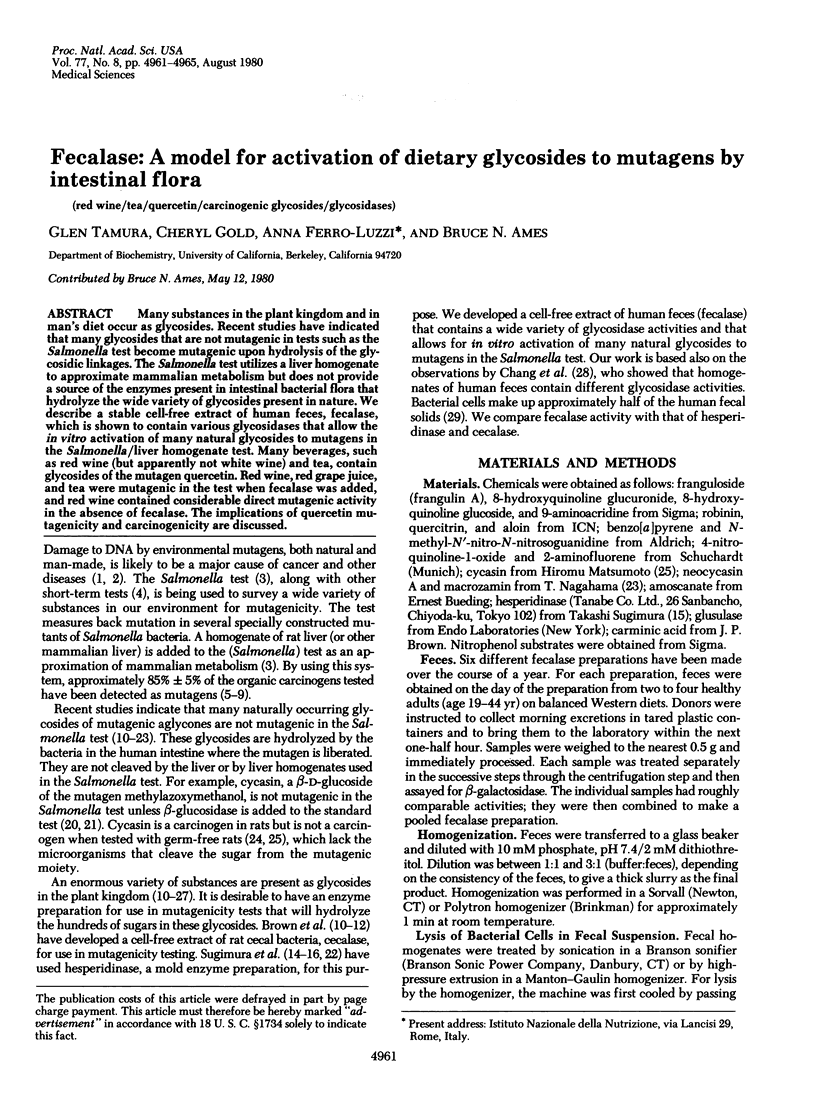
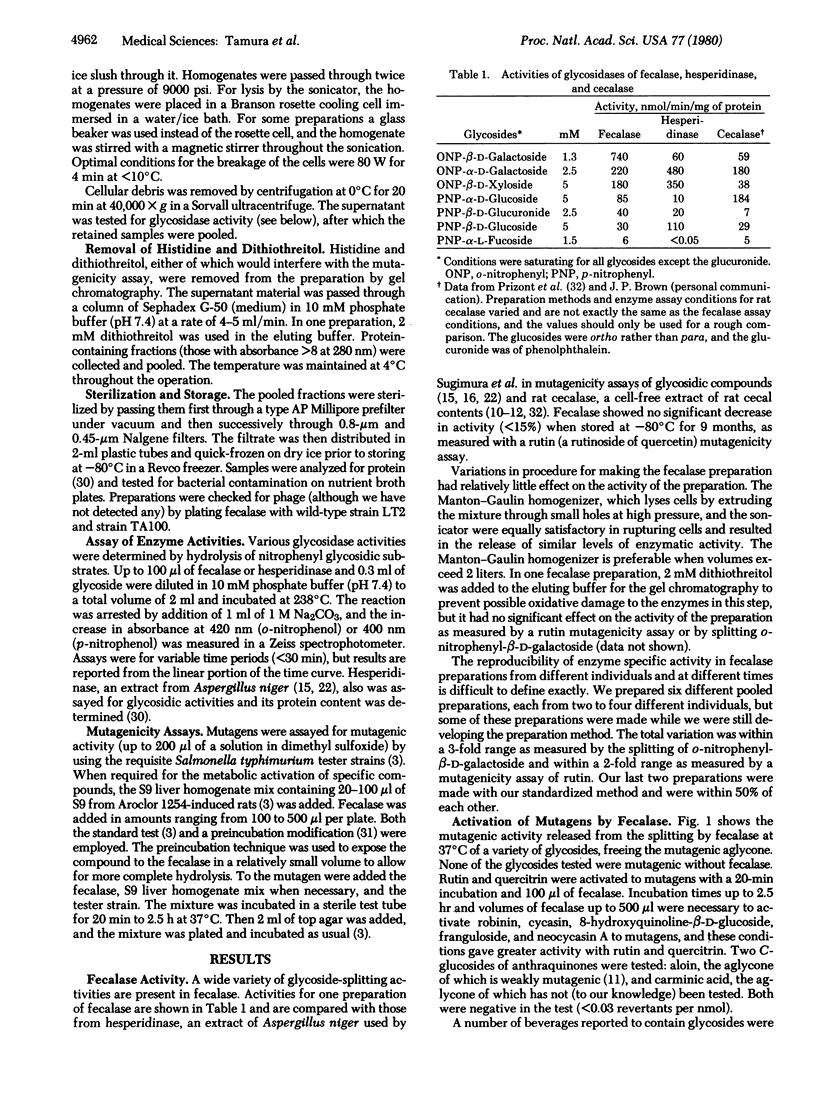
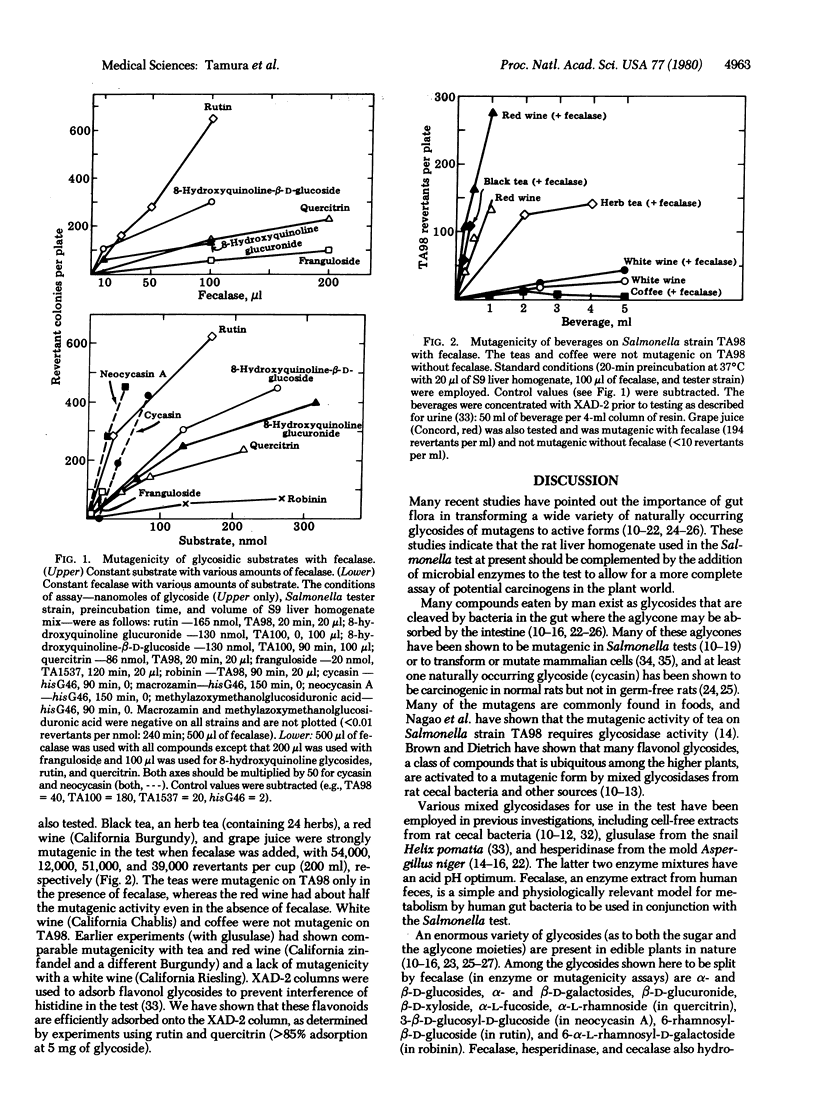
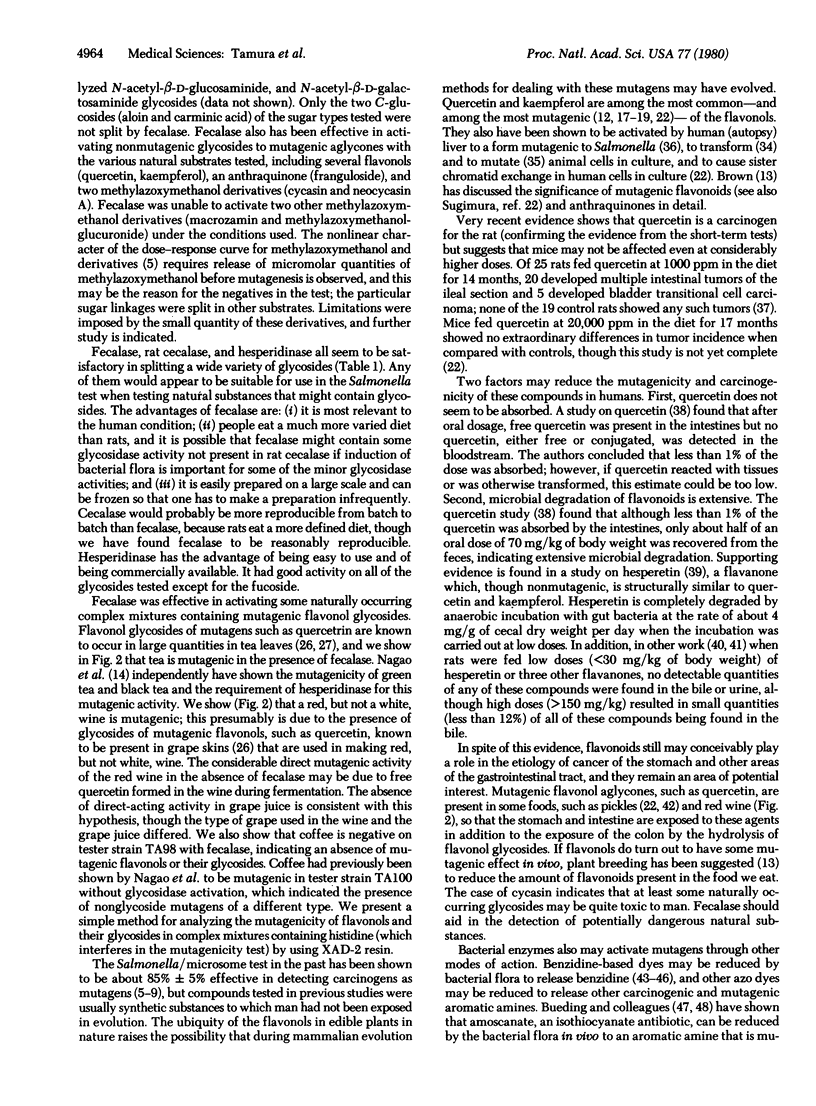
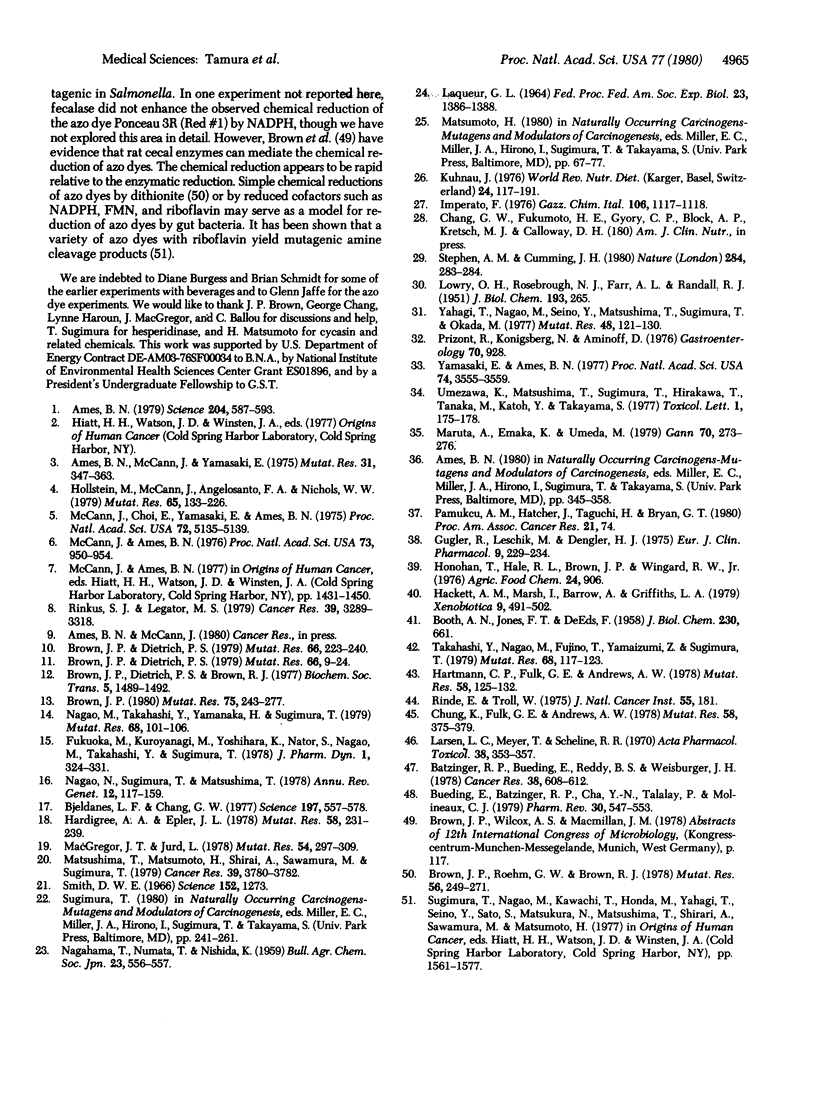
Selected References
These references are in PubMed. This may not be the complete list of references from this article.
- Ames B. N. Identifying environmental chemicals causing mutations and cancer. Science. 1979 May 11;204(4393):587–593. doi: 10.1126/science.373122. [DOI] [PubMed] [Google Scholar]
- Ames B. N., Mccann J., Yamasaki E. Methods for detecting carcinogens and mutagens with the Salmonella/mammalian-microsome mutagenicity test. Mutat Res. 1975 Dec;31(6):347–364. doi: 10.1016/0165-1161(75)90046-1. [DOI] [PubMed] [Google Scholar]
- BOOTH A. N., JONES F. T., DeEDS F. Metabolic fate of hesperidin, eriodictyol, homoeridictyol, and diosmin. J Biol Chem. 1958 Feb;230(2):661–668. [PubMed] [Google Scholar]
- Batzinger R. P., Bueding E., Reddy B. S., Weisburger J. H. Formation of a mutagenic drug metabolite by intestinal microorganisms. Cancer Res. 1978 Mar;38(3):608–612. [PubMed] [Google Scholar]
- Bjeldanes L. F., Chang G. W. Mutagenic activity of quercetin and related compounds. Science. 1977 Aug 5;197(4303):577–578. doi: 10.1126/science.327550. [DOI] [PubMed] [Google Scholar]
- Brown J. P. A review of the genetic effects of naturally occurring flavonoids, anthraquinones and related compounds. Mutat Res. 1980 May;75(3):243–277. doi: 10.1016/0165-1110(80)90029-9. [DOI] [PubMed] [Google Scholar]
- Brown J. P., Dietrich P. S., Brown R. J. Frameshift mutagenicity of certain naturally occurring phenolic compounds in the 'Salmonella/microsome' test: activation of anthraquinone and flavonol glycosides by gut bacterial enzymes [proceedings]. Biochem Soc Trans. 1977;5(5):1489–1492. doi: 10.1042/bst0051489. [DOI] [PubMed] [Google Scholar]
- Brown J. P., Dietrich P. S. Mutagenicity of anthraquinone and benzanthrone derivatives in the Salmonella/microsome test: activation of anthraquinone glycosides by enzymic extracts of rat cecal bacteria. Mutat Res. 1979 Jan;66(1):9–24. doi: 10.1016/0165-1218(79)90003-x. [DOI] [PubMed] [Google Scholar]
- Brown J. P., Dietrich P. S. Mutagenicity of plant flavonols in the Salmonella/mammalian microsome test: activation of flavonol glycosides by mixed glycosidases from rat cecal bacteria and other sources. Mutat Res. 1979 Mar;66(3):223–240. doi: 10.1016/0165-1218(79)90083-1. [DOI] [PubMed] [Google Scholar]
- Brown J. P., Roehm G. W., Brown R. J. Mutagenicity testing of certified food colors and related azo, xanthene and triphenylmethane dyes with the Salmonella/microsome system. Mutat Res. 1978 Jan;56(3):249–271. doi: 10.1016/0027-5107(78)90192-6. [DOI] [PubMed] [Google Scholar]
- Bueding E., Batzinger R. P., Cha Y. N., Talalay P., Molineaux C. J. Protection from mutagenic effects of antischistosomal and other drugs. Pharmacol Rev. 1978 Dec;30(4):547–554. [PubMed] [Google Scholar]
- Chung K. T., Fulk G. E., Andrews A. W. The mutagenicity of methyl orange and metabolites produced by intestinal anaerobes. Mutat Res. 1978 Nov;58(2-3):375–379. doi: 10.1016/0165-1218(78)90033-2. [DOI] [PubMed] [Google Scholar]
- Gugler R., Leschik M., Dengler H. J. Disposition of quercetin in man after single oral and intravenous doses. Eur J Clin Pharmacol. 1975 Dec 19;9(2-3):229–234. doi: 10.1007/BF00614022. [DOI] [PubMed] [Google Scholar]
- Hackett A. M., Marsh I., Barrow A., Griffiths L. A. The bilary excretion of flavanones in the rat. Xenobiotica. 1979 Aug;9(8):491–501. doi: 10.3109/00498257909087263. [DOI] [PubMed] [Google Scholar]
- Hardigree A. A., Epler J. L. Comparative mutagenesis of plant flavonoids in microbial systems. Mutat Res. 1978 Nov;58(2-3):231–239. doi: 10.1016/0165-1218(78)90014-9. [DOI] [PubMed] [Google Scholar]
- Hartman C. P., Fulk G. E., Andrews A. W. Azo reduction of trypan blue to a known carcinogen by a cell-free extract of a human intestinal anaerobe. Mutat Res. 1978 Nov;58(2-3):125–132. doi: 10.1016/0165-1218(78)90001-0. [DOI] [PubMed] [Google Scholar]
- Hollstein M., McCann J., Angelosanto F. A., Nichols W. W. Short-term tests for carcinogens and mutagens. Mutat Res. 1979 Sep;65(3):133–226. doi: 10.1016/0165-1110(79)90014-9. [DOI] [PubMed] [Google Scholar]
- Honohan T., Hale R. L., Brown J. P., Wingard R. E., Jr Synthesis and metabolic fate of hesperetin-3-14C. J Agric Food Chem. 1976 Sep-Oct;24(5):906–911. doi: 10.1021/jf60207a031. [DOI] [PubMed] [Google Scholar]
- Kühnau J. The flavonoids. A class of semi-essential food components: their role in human nutrition. World Rev Nutr Diet. 1976;24:117–191. [PubMed] [Google Scholar]
- LAQUEUR G. L. CARCINOGENIC EFFECTS OF CYCAD MEAL AND CYCASIN, METHYLAZOXYMETHANOL GLYCOSIDE, IN RATS AND EFFECTS OF CYCASIN IN GERMFREE RATS. Fed Proc. 1964 Nov-Dec;23:1386–1388. [PubMed] [Google Scholar]
- LOWRY O. H., ROSEBROUGH N. J., FARR A. L., RANDALL R. J. Protein measurement with the Folin phenol reagent. J Biol Chem. 1951 Nov;193(1):265–275. [PubMed] [Google Scholar]
- Larsen J. C., Meyer T., Scheline R. R. Reduction of sulphonated water-soluble azo dyes by caecal microorganisms from the rat. Acta Pharmacol Toxicol (Copenh) 1976 Apr;38(4):353–357. doi: 10.1111/j.1600-0773.1976.tb03130.x. [DOI] [PubMed] [Google Scholar]
- MacGregor J. T., Jurd L. Mutagenicity of plant flavonoids: structural requirements for mutagenic activity in Salmonella typhimurium. Mutat Res. 1978 Dec;54(3):297–309. doi: 10.1016/0165-1161(78)90020-1. [DOI] [PubMed] [Google Scholar]
- Maruta A., Enaka K., Umeda M. Mutagenicity of quercetin and kaempferol on cultured mammalian cells. Gan. 1979 Jun;70(3):273–276. [PubMed] [Google Scholar]
- Matsushima T., Matsumoto H., Shirai A., Sawamura M., Sugimura T. Mutagenicity of the naturally occurring carcinogen cycasin and synthetic methylazoxymethanol conjugates in Salmonella typhimurium. Cancer Res. 1979 Sep;39(9):3780–3782. [PubMed] [Google Scholar]
- McCann J., Ames B. N. Detection of carcinogens as mutagens in the Salmonella/microsome test: assay of 300 chemicals: discussion. Proc Natl Acad Sci U S A. 1976 Mar;73(3):950–954. doi: 10.1073/pnas.73.3.950. [DOI] [PMC free article] [PubMed] [Google Scholar]
- McCann J., Choi E., Yamasaki E., Ames B. N. Detection of carcinogens as mutagens in the Salmonella/microsome test: assay of 300 chemicals. Proc Natl Acad Sci U S A. 1975 Dec;72(12):5135–5139. doi: 10.1073/pnas.72.12.5135. [DOI] [PMC free article] [PubMed] [Google Scholar]
- Nagao M., Sugimura T., Matsushima T. Environmental mutagens and carcinogens. Annu Rev Genet. 1978;12:117–159. doi: 10.1146/annurev.ge.12.120178.001001. [DOI] [PubMed] [Google Scholar]
- Nagao M., Takahashi Y., Yamanaka H., Sugimura T. Mutagens in coffee and tea. Mutat Res. 1979 Oct;68(2):101–106. doi: 10.1016/0165-1218(79)90137-x. [DOI] [PubMed] [Google Scholar]
- Rinde E., Troll W. Metabolic reduction of benzidine azo dyes to benzidine in the rhesus monkey. J Natl Cancer Inst. 1975 Jul;55(1):181–182. doi: 10.1093/jnci/55.1.181. [DOI] [PubMed] [Google Scholar]
- Rinkus S. J., Legator M. S. Chemical characterization of 465 known or suspected carcinogens and their correlation with mutagenic activity in the Salmonella typhimurium system. Cancer Res. 1979 Sep;39(9):3289–3318. [PubMed] [Google Scholar]
- Smith D. W. Mutagenicity of cycasin aglycone (methylazoxymethanol), a naturally occurring carcinogen. Science. 1966 May 27;152(3726):1273–1274. doi: 10.1126/science.152.3726.1273. [DOI] [PubMed] [Google Scholar]
- Stephen A. M., Cummings J. H. Mechanism of action of dietary fibre in the human colon. Nature. 1980 Mar 20;284(5753):283–284. doi: 10.1038/284283a0. [DOI] [PubMed] [Google Scholar]
- Takahashi Y., Nagao M., Fujino T., Yamaizumi Z., Sugimura T. Mutagens in Japanese pickle identified as flavonoids. Mutat Res. 1979 Oct;68(2):117–123. doi: 10.1016/0165-1218(79)90139-3. [DOI] [PubMed] [Google Scholar]
- Yahagi T., Nagao M., Seino Y., Matsushima T., Sugimura T. Mutagenicities of N-nitrosamines on Salmonella. Mutat Res. 1977 Apr;48(2):121–129. doi: 10.1016/0027-5107(77)90151-8. [DOI] [PubMed] [Google Scholar]
- Yamasaki E., Ames B. N. Concentration of mutagens from urine by absorption with the nonpolar resin XAD-2: cigarette smokers have mutagenic urine. Proc Natl Acad Sci U S A. 1977 Aug;74(8):3555–3559. doi: 10.1073/pnas.74.8.3555. [DOI] [PMC free article] [PubMed] [Google Scholar]


